The global laboratory furnaces market recorded sales of USD 361.9 million in 2024 and is projected to grow to USD 380.7 million in 2025, reflecting a year-on-year growth rate of 4.4%. Over the forecast period from 2025 to 2035, the market is expected to expand at a CAGR of 5.2%, reaching an estimated value of USD 632.1 million by 2035.
Growth in the laboratory furnaces market is driven by increasing demand from research institutions, pharmaceutical companies, and industrial laboratories for precise and reliable heating equipment. These furnaces are essential for applications such as material testing, thermal processing, and quality control, where accurate temperature control is critical.
Technological advancements are playing a significant role in market development. Innovations include energy-efficient furnace designs that reduce power consumption without compromising performance. Manufacturers are incorporating advanced digital controllers and automation features to enhance operational accuracy and ease of use. Companies like Carbolite Gero and Nabertherm have introduced smart furnaces with programmable heating profiles and remote monitoring capabilities, improving laboratory efficiency.
The pharmaceutical and biotechnology sectors are key end-users, where laboratory furnaces are used for sterilization, sample preparation, and material characterization. Growing investments in drug development and quality assurance are driving furnace demand in these industries.
Regionally, North America and Europe dominate the laboratory furnaces market due to the presence of advanced research infrastructure and stringent quality standards. However, the Asia Pacific region is projected to exhibit the highest growth rate, fueled by expanding industrial R&D activities and increasing government support for scientific research in countries like China, India, and Japan.
In 2024, Carbolite Gero launched a new range of electric laboratory furnaces featuring enhanced insulation and energy-saving technologies, underscoring the industry’s commitment to sustainability and efficiency.
With ongoing innovation and rising demand for precision heating solutions, the laboratory furnaces market is poised for steady growth through 2035, driven by expanding applications across research and industrial sectors.
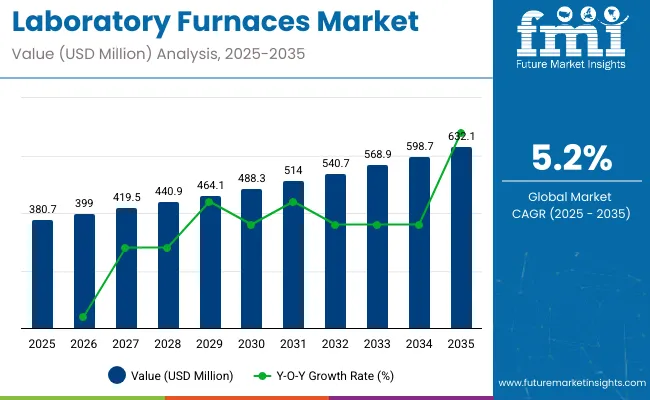
| Attributes | Key Insights |
|---|---|
| Estimated Size, 2025 | USD 380.7 million |
| Projected Size, 2035 | USD 632.1 million |
| Value-based CAGR (2025 to 2035) | 5.2% |
Laboratory furnaces, widely used in industries like pharmaceuticals, materials science, and research laboratories, are subject to stringent regulatory standards to ensure safety, reliability, and environmental compliance. These standards govern aspects such as electrical safety, thermal performance, and hazardous material handling. Manufacturers must adhere to various international certifications and regulations to ensure their products meet the required safety and operational criteria.
The global trade of laboratory furnaces is driven by growing demand across various sectors such as research institutions, pharmaceuticals, materials science, and industrial testing. As laboratory environments become more advanced and specialized, the need for high-performance, precise, and safe laboratory furnaces has increased. Trade patterns are influenced by regional manufacturing hubs, technological advancements, and international research collaborations.
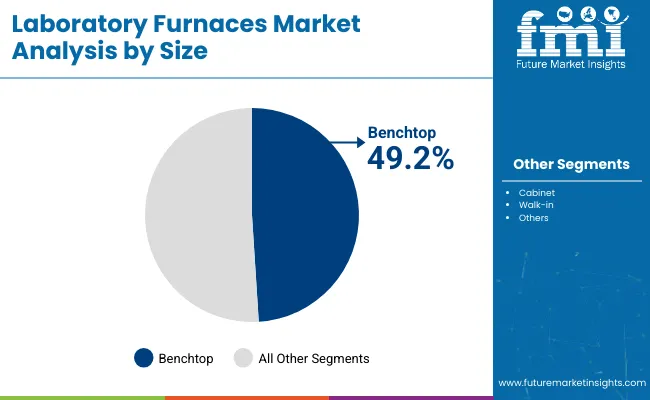
Benchtop furnaces are anticipated to dominate the laboratory furnace market, expected to capture about 49.2% market share in 2025. Their compact size and economical pricing make them highly attractive for use in academic institutions, research laboratories, and small-scale industrial operations. The design of benchtop furnaces allows them to fit easily into constrained laboratory spaces, making them ideal where space is at a premium.
Their versatility enables them to perform a variety of functions such as small-scale experimentation, routine testing, and precise temperature control, which is crucial in fields like pharmaceuticals, biotechnology, and material science. The growing emphasis on controlled thermal processing in these industries is driving demand for benchtop furnaces. Furthermore, their user-friendly interfaces and reliable performance make them accessible to a wide range of users, from students to researchers. As precision temperature control becomes increasingly important for scientific and industrial applications, benchtop furnaces are set to maintain their leading position in the market through 2025.
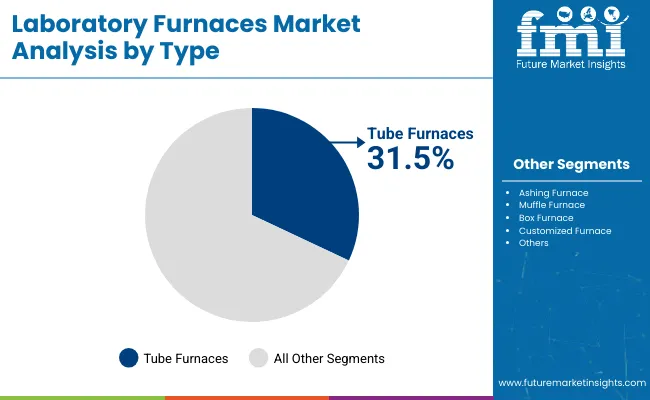
Tube furnaces are forecasted to hold an estimated 31.5% market share in 2025, driven by their ability to provide precise, high-temperature heating under controlled conditions. These furnaces are widely utilized in materials science, chemical analysis, and metallurgical processes due to their uniform heat distribution and capacity for sample insertion.
Applications such as sintering, annealing, and thermal decomposition benefit from the consistent temperature environment offered by tube furnaces. Their design supports small-scale production and high-temperature testing, essential for quality control and product development in industrial and research settings. The demand for accurate temperature control and the ability to handle diverse samples continues to propel the growth of tube furnaces. With their proven reliability and multifunctionality, tube furnaces remain vital equipment for laboratories and industries aiming to meet evolving research and manufacturing standards through 2025.
The table below presents the annual growth rates of the global laboratory furnaces industry from 2025 to 2035. With a base year of 2024 extending to the current year 2025, the report examines how the sector's growth trajectory evolves from the first half of the year (January to June, H1) to the second half (July to December, H2). This analysis offers stakeholders insights into the industry's performance over time, highlighting potential developments that may emerge.
These figures indicate the growth of the sector in each half year, between the years 2024 and 2025. The industry is expected to grow at a CAGR of 4.9% in H1-2024. In H2, the growth rate increases.
| Particular | Value CAGR |
|---|---|
| H1 2024 | 4.9% (2024 to 2034) |
| H2 2024 | 5.1% (2024 to 2034) |
| H1 2025 | 5.2% (2025 to 2035) |
| H2 2025 | 5.3% (2025 to 2035) |
Moving into the subsequent period, from H1 2025 to H2 2025, the CAGR is projected to slightly decrease to 5.2% in the first half and relatively increase to 5.3% in the second half. In the first half (H1), the sector saw an increase of 30 BPS while in the second half (H2), there was a slight increase of 20 BPS.
Rising Demand for High-Precision Heating in Pharmaceuticals and Biotechnology
The high demand of pharmaceutical and biotechnology industries for furnaces with high precision of heating is the key growth driver in the market of laboratory furnaces. In these industries, precise temperature control is applied to such applications as development of different drugs, synthesis of bioactive compounds, sterilization, and sample preparation.
In pharmaceutical research, laboratory furnaces play a crucial role in key applications such as ashing, drying, and sterilizing of materials used in the formulation of drugs for their safety and effectiveness. The furnaces also form an important part in biotechnology for the preparation of cell cultures, synthesis of proteins, and bio-materials.
The need for accurate and high-temperature control will further increase with the advancements in biotech innovations and personalized medicine, catering to increasing stringent quality standards. Increased complexity of experiments and a rising focus on the manufacturing of biopharmaceuticals drive the demand for laboratory furnaces with advanced features, which enable accurate temperature regulation and thereby help boost the market growth.
Increased Focus on Quality Control and Testing in Metal and Mining
The increasing emphasis on quality control and testing within the metal and mining industries propels the market of laboratory furnaces. Growth in these industries across the globe will raise demand for precise testing in order to guarantee the quality and durability of materials in construction, manufacturing, and infrastructure.
Laboratory furnaces play a very important role in such processes like sintering, alloying, and heat treatment, which are crucial for the determination of properties and performances of metals and minerals.
Precise temperature control in furnaces ensures uniform heating, which is very important to achieve desired material properties such as hardness, tensile strength, and resistance to corrosion. Besides this, greater demand for eco-friendly mining and sustainable productions has placed greater demands on laboratory furnaces, both in efficient testing and material processing. Quality control and various tests in the metal and mining industries remain key drivers that can continue to propel this market with advanced laboratory furnaces.
Growing Need for High-Temperature Testing in Oil and Gas Laboratories
The high-temperature test requirement is increasing, especially in oil and gas laboratories, due to an increased emphasis by the industry on durability and safety in extreme conditions. In materials testing-such as metals, alloys, and composites used in the processes of drilling, extraction, and refining-furnaces are needed.
Such testing helps in the simulation of extreme environments to which the materials will be subjected and assures resistance to high temperatures, pressures, and corrosive attacks. It involves a high-precision furnace, for testing material performance according to safety and industrial standards in the future, reducing its possibility of failure during operation.
The need for sophisticated high-temperature testing is fast increasing, especially as oil and gas exploration goes to more challenging and deeper environments. Laboratory furnaces are needed in conducting tests for components usually exposed to extreme conditions, such as those used in deep-sea drilling, offshore rigs, and deep underground exploration. This demand is, therefore, driving the growth of the market for laboratory furnaces in oil and gas laboratories.
High Initial Investment Costs for Laboratory Furnace Equipment
Among financial burdens on SMEs, high investment costs in the initial stages are seen in the case of laboratory furnace equipment. Most such organizations suffer from capital constraints while buying advanced models of furnaces that come with precision in temperature control, safety features, and options for customization. This, in turn, has restricted or delayed their upgrading or investment in high-performance laboratory furnaces, which has, in turn, hampered market penetration.
In emerging markets, where the industrial and research infrastructural budgets are usually not very high, the cost of laboratory furnaces can become a constraint in the rate of growth. In such regions, despite growing demand for good-quality test equipment, the initial purchase price barrier remains the obstacle to further growth in the diffusion of laboratory furnaces and overall market growth.
Lack of Skilled Workforce for Proper Operation and Maintenance of Laboratory Furnaces in Certain Regions
Restraint in the laboratory furnace market is the lack of skilled workforce in certain regions, especially in developing and emerging markets. High-precision laboratory furnaces require trained professionals to operate and maintain the intricacies of furnace calibration, temperature control, and safety protocols.
In areas where this expertise might be limited, it becomes a challenge to ensure these furnaces operate correctly, mostly at levels of inefficiency and poor safety. Shortages in skilled technicians remain a constraint to adoption and proper exploitation of laboratory furnaces into key sectors of high development impact, like pharmaceutical, metallurgy, and biotechnological industries.
Another constraint involves the cost and effort that go into the training of personnel for operating and maintaining laboratory furnaces. Most regions face difficulty in arranging such resources for continuous training programs. This gap in technical education and workforce development has been holding back the wide application of laboratory furnaces, especially in smaller laboratories or newly established facilities, further restricting market growth.
The global laboratory furnaces industry recorded a CAGR of 4.6% during the historical period between 2020 and 2024. The growth of laboratory furnaces industry was positive as it reached a value of USD 361.9 million in 2024 from USD 297.6 million in 2020.
The global laboratory furnaces market has recorded considerable growth on the back of rising demand from the pharmaceutical and biotechnology industries. This is because, with the growth of these industries, high-precision equipment like laboratory furnaces became highly sought after to support applications such as drug development, bio manufacturing, and material testing.
These furnaces are used for sterilization, sample preparation, and ensuring that materials meet stringent safety and quality standards. The rapid growth of research in drug development and biopharmaceutical manufacturing contributed much to the market growth.
Growing emphasis on scientific research and technological advancement in academics and research institutes is one of the key factors that drove the market for laboratory furnaces. Educational and research institutes require better laboratory equipment to support their experiments and projects as more scientific research is being funded by governments and private investors. This demand from educational and research institutions contributed to the positive growth of the market during the historical period.
Tier 1 companies include industry leaders with annual revenues exceeding USD 10-15 million. These companies are currently capturing a significant share of 40-45% globally. These frontrunners are characterized by high production capacity and a wide product portfolio.
They are distinguished by extensive expertise in manufacturing and a broad geographical reach, underpinned by a robust consumer base. The firms provide a wide range of products and utilize the latest technology to meet regulatory standards. Prominent companies within Tier 1 include : Thermo Fisher Scientific, CARBOLITE GERO, Nabertherm GmbH, C M Furnaces Inc., and others
Tier 2 companies encompass mid-sized participants with revenues ranging from USD 5-10 million, holding a presence in specific regions and exerting significant influence in local economies. These firms are distinguished by robust presence overseas and in-depth industry expertise.
They possess strong technology capabilities and adhere strictly to regulatory requirements. However, the firms may not wield cutting-edge technology or maintain an extensive global reach. Noteworthy entities in Tier 2 include Across International, Yamato Scientific co., ltd, BIO BASE, and few others.
Tier 3 encompasses most of the small-scale enterprises operating within the regional sphere and catering to specialized needs with revenues below USD 5 million. These businesses are notably focused on meeting local demand and are hence categorized within the Tier 3 segment.
They are small-scale participants with limited geographical presence. In this context, Tier 3 is acknowledged as an informal sector, indicating a segment distinguished by a lack of extensive organization and formal structure in comparison to the structured one. Tier 3 includes Thermcraft Incorporated, Hobersal, Lindberg/MPH, and many more small and local players.
The section below highlights assessments of laboratory furnaces market sale across key countries. USA, China, Japan, and Turkey are expected to showcase promising double-digit growth, with each exhibiting a strong CAGR through the forecast period.
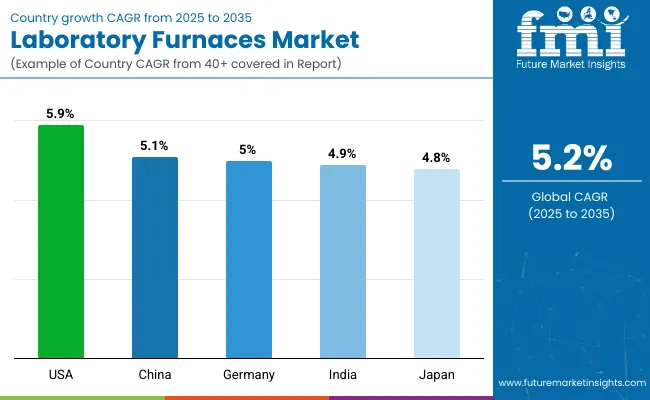
| Countries | Value CAGR (2025 to 2035) |
|---|---|
| USA | 5.9% |
| China | 5.1% |
| Germany | 5.0% |
| India | 4.9% |
| Japan | 4.8% |
The USA pharmaceutical and biotechnology industries are considered a driving force for the market in laboratory furnaces. These industries involve high-precision equipment in different operations, such as drug development, material testing, and manufacturing of biopharmaceuticals.
Laboratory furnaces have widespread applications in sterilization, heat treatment, and NGS sample preparation, integral to the safety, quality, and efficacy of drug manufacturing. With the USA continuing to invest in biotech innovation, especially in personalized medicine and biologics, there is an increased demand for advanced laboratory furnaces.
The academic and research sectors in the USA are another leading contributor of the marketplace because of highly advanced funding in scientific research. Laboratory furnaces at universities and private research facilities become indispensable for material analysis, nanotechnology research, and various other advanced materials science experiments.
All these factors have continuously driven demand for high-level laboratory furnaces that could support such complicated experiments within disciplines like chemistry, materials engineering, and environmental sciences.
Industrial manufacturing and the processing of metallurgical segments fuel the demand for laboratory furnaces in China. This was due to China's rapid extension in its base for the manufacture of goods, especially steel products, electrical, and automobiles that require laboratory furnaces with precise temperature control measures used in sintering, test, and heat treatment in lots of these industries. Laboratory furnaces have become very significant in material durability, quality control, and performance testing in order to meet the global industry standards.
This rising focus of China on material science and advanced research acts to fuel the demand for laboratory furnaces. As this country invests in the making of new materials for new technologies such as in electronic, renewable energy, and aerospace industries, laboratory furnaces become critical in studying the properties of these various materials.
They enable one to study high-temperature behavior, material synthesis, and experimentation with precision; hence, they support the ambition of China to reach world leadership in advanced manufacturing and scientific research.
The German automotive industry drives the growth of the laboratory furnaces market. Local car manufacturers have to test and analyze the materials of components, such as engine parts, transmission, and batteries, with high accuracy. Laboratory furnaces will be required for heat treatment and material testing to ensure that automotive materials are long-lasting and perform well.
Along with further development in automotive technologies, particularly in electric vehicles, there should be a demand creation in laboratory furnaces that would meet present needs and assist in testing and studies of new materials and coatings.
Germany’s pharmaceutical and chemical industry needs are also boosting laboratory furnaces market. Furnaces are extensively used in the manufacturing of pharmaceutical to sterilize newly developed drugs, to prepare samples for investigational study and to determine therapeutic characteristics of drugs as per pharmacopeia.
The chemical industry utilizes furnaces for the synthesis of different materials, investigation on reaction kinetics of new and established products along with process designing. Steady innovation in these domains will foster demand for high-precision laboratory equipment, hence fueling sales for furnaces.
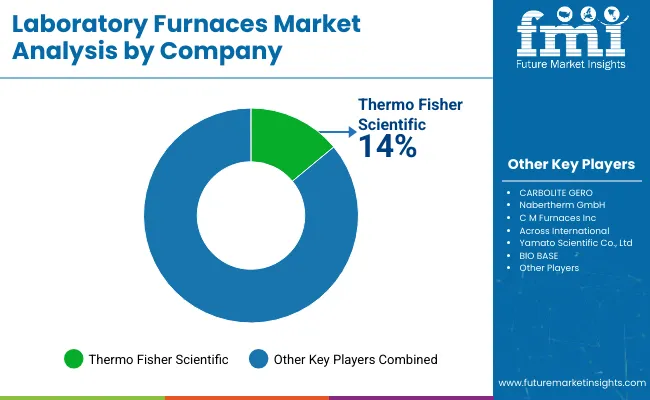
The section provides comprehensive assessments and insights that highlight current opportunities and emerging trends for companies in developed and developing countries. It analyzes advancements in manufacturing and identifies the latest trends poised to drive new applications in the market.
A few key players in the laboratory furnaces industry are actively enhancing capabilities and resources to cater to the growing demand for the compound across diverse applications. Leading companies also leverage partnership and joint venture strategies to co-develop innovative products and bolster resource base.
Significant players are further introducing new products to address the increasing need for cutting-edge solutions in various end-use sectors. Geographic expansion is another important strategy that is being embraced by reputed companies. Start-ups are likely to emerge in the sector through 2035, thereby making it more competitive.
| Report Attributes | Details |
|---|---|
| Current Total Market Size (2024) | USD 361.9 million |
| Current Total Market Size (2025) | USD 380.7 million |
| Projected Market Size (2035) | USD 632.1 million |
| CAGR (2025 to 2035) | 5.2% |
| Base Year for Estimation | 2024 |
| Historical Period | 2020 to 2024 |
| Projections Period | 2025 to 2035 |
| Quantitative Units | USD million for value and units for volume |
| Types Analyzed (Segment 1) | Ashing Furnace, Muffle Furnace, Box Furnace, Tube Furnace, Customized Furnace |
| Sizes Analyzed (Segment 2) | Benchtop, Cabinet, Walk-in |
| Temperature Ranges Analyzed (Segment 3) | Below 1000°C, 1000–1500°C, Above 1500°C |
| End Uses Analyzed (Segment 4) | Pharmaceutical, Biotechnology, Academic and Research Institutes, Diagnostic Centers, Metal and Mining, Oil and Gas Laboratory, Others |
| Regions Covered | North America; Latin America; Western Europe; Eastern Europe; South Asia and Pacific; East Asia; Middle East & Africa |
| Countries Covered | United States, Canada, Mexico, Brazil, Argentina, Germany, France, United Kingdom, Italy, Spain, Netherlands, China, India, Japan, South Korea, ANZ, GCC Countries, South Africa |
| Key Players influencing the Laboratory Furnaces Market | Thermo Fisher Scientific, CARBOLITE GERO, Nabertherm GmbH, C M Furnaces Inc, Across International, Yamato Scientific Co., Ltd, BIO BASE, Thermcraft Incorporated, Hobersal, Lindberg/MPH |
| Additional Attributes | Dollar sales by size category (benchtop, cabinet, walk-in), Furnace type adoption trends across industries, Regional investment in scientific instrumentation, Trends in high-temperature and customized furnace applications, Role of precision heating in academic and diagnostics research |
| Customization and Pricing | Customization and Pricing Available on Request |
In terms of type, the industry is divided into Ashing Furnace, Muffle Furnace, Box Furnace, Tube Furnace, and Customized Furnace.
In terms of size, the industry is divided into Benchtop, Cabinet, and Walk-in.
In terms of temperature, the industry is divided into Below 1000 deg.C., 1000 - 1500 deg.C., and Above 1500 deg.C.
In terms of end use, the industry is divided into Pharmaceutical, Biotechnology, Academic and Research Institutes, Diagnostic Centers, Metal and Mining, Oil and Gas Laboratory, and Others.
Key countries of North America, Latin America, Western Europe, Eastern Europe, East Asia, South Asia, Middle East and Africa (MEA), have been covered in the report.
The global market was valued at USD 361.9 million in 2024.
The global market is set to reach USD 380.7 million in 2025.
Global demand is anticipated to rise at 5.2% CAGR.
The industry is projected to reach USD 632.1 million by 2035.






Full Research Suite comprises of:
Market outlook & trends analysis
Interviews & case studies
Strategic recommendations
Vendor profiles & capabilities analysis
5-year forecasts
8 regions and 60+ country-level data splits
Market segment data splits
12 months of continuous data updates
DELIVERED AS:
PDF EXCEL ONLINE
Laboratory Information System Market Forecast and Outlook 2025 to 2035
Laboratory Centrifuge & Accessories Market Size and Share Forecast Outlook 2025 to 2035
Laboratory Shakers Market Size and Share Forecast Outlook 2025 to 2035
Laboratory Washers Market Size and Share Forecast Outlook 2025 to 2035
Laboratory Rockers and Shakers Market Size and Share Forecast Outlook 2025 to 2035
Laboratory Filtration Devices Market Size and Share Forecast Outlook 2025 to 2035
Laboratory and Medical Scale Ozone Generator Market Size and Share Forecast Outlook 2025 to 2035
Laboratory Supplies Market Size and Share Forecast Outlook 2025 to 2035
Laboratory Benchtop Automation Market Growth – Trends & Forecast 2025 to 2035
Laboratory Balances and Scales Market Growth - Industry Forecast 2025 to 2035
Global Laboratory Filter Paper Market Growth – Trends & Forecast 2024-2034
Laboratory Sample Container Market
Laboratory Filtration Equipment Market Growth – Trends & Forecast 2019-2027
Laboratory Glassware and Plasticware Market
Laboratory Ovens Market Analysis by Mechanical Convection and Vacuum Ovens Type through 2035
AI in Laboratory Solution Market Size and Share Forecast Outlook 2025 to 2035
Dental Laboratory Market Size and Share Forecast Outlook 2025 to 2035
Laboratory Grinders Market Size and Share Forecast Outlook 2025 to 2035
Service Laboratory Market Analysis by Service Type, Deployment, Channel, End-user, and Region Through 2035
Analytical Laboratory Service Market Size and Share Forecast Outlook 2025 to 2035

Thank you!
You will receive an email from our Business Development Manager. Please be sure to check your SPAM/JUNK folder too.
Chat With
MaRIA